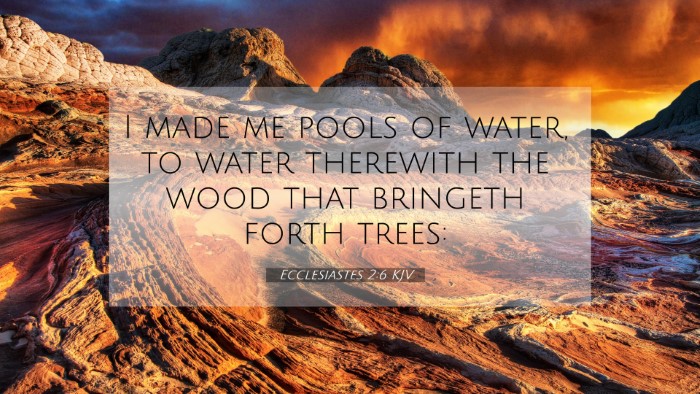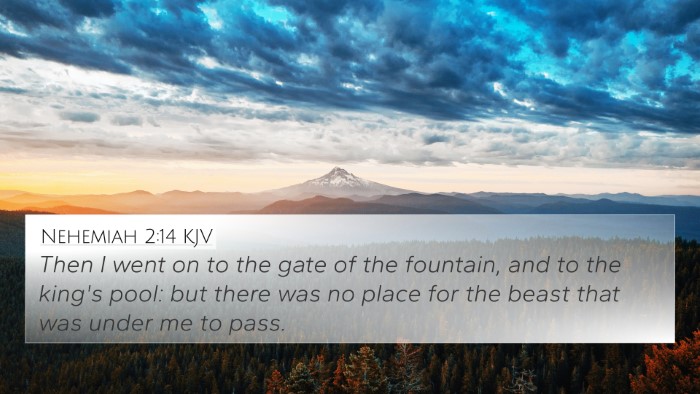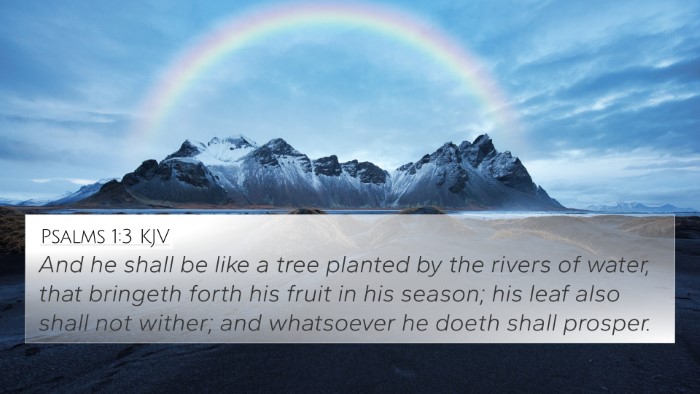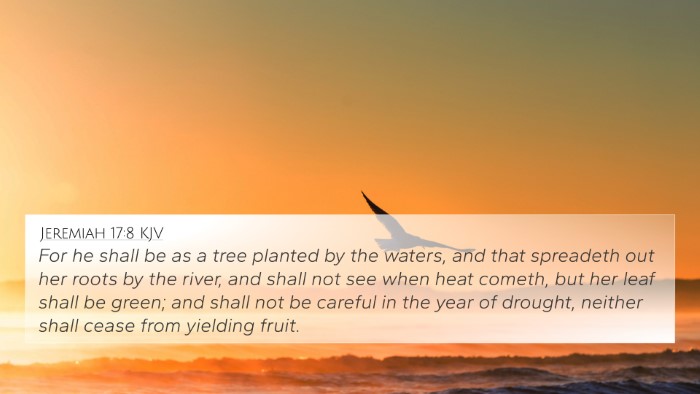Understanding Ecclesiastes 2:6
Ecclesiastes 2:6 reads: "I made pools of water for myself, to water the forest of growing trees." This verse is part of a larger discourse where the Preacher, traditionally understood to be Solomon, reflects on the meaning of life and the pursuits of pleasure and achievement.
Meaning and Interpretation
The verse highlights the actions of the Preacher, representing a pursuit of pleasure and abundance. The act of making pools of water signifies preparation for enjoyment and sustenance, indicating a desire for control over his environment, particularly over nature. The growing trees symbolize flourishing life, which could denote vitality and the fruits of one’s labors.
Insights from Public Domain Commentaries
Matthew Henry's Commentary
Matthew Henry points out how the Preacher, despite his grand achievements, often reflects on the fleeting nature of worldly pleasures. His creation of pools can be likened to the efforts individuals put into ensuring their own happiness, yet it serves as a reminder of the ultimate vanity that such pursuits might lead to. Henry emphasizes that while the act of watering and cultivating brings about growth, it also suggests an underlying search for something more permanent than fleeting pleasures.
Albert Barnes' Notes
Albert Barnes adds that the pools represent not only a physical labor but also a metaphorical one, indicating the longing for meaningful contributions to life. He suggests that the labor involved in creating these water sources reflects a greater existential quest for fulfillment. Barnes also notes that the use of water—essential for life—places emphasis on the importance of relying on God as the ultimate source of spiritual nourishment, drawing parallels between physical and spiritual sustenance.
Adam Clarke's Commentary
Adam Clarke offers insights into the effort put forth in the construction of the pools, illustrating a human tendency to seek satisfaction in material pursuits. Clarke discusses how Solomon's actions serve as a commentary on human endeavor and the need to contemplate the worth of such efforts. He emphasizes that these pursuits may lead individuals to reflect on higher spiritual meanings that transcend mere physical endeavors.
Cross-References
- Genesis 2:10 - Discusses a river watering the garden, paralleling the theme of creation and sustenance.
- Psalms 1:3 - A tree planted by the water, showing the significance of spiritual nourishment.
- John 4:14 - Jesus speaks of living water, connecting physical thirst to spiritual enrichment.
- Isaiah 58:11 - God promises to guide and satisfy like a well-watered garden.
- Jeremiah 17:8 - A tree by the waters extending roots, representing stability in faith amidst circumstances.
- Revelation 22:1 - The river of life flowing from the throne of God, indicating ultimate sustenance.
- Mark 4:14 - The parable of the sower speaks to growth and planting related to spiritual realization.
Thematic Connections
Ecclesiastes 2:6 opens up several thematic connections within the Bible regarding spiritual nourishment, vanity of human endeavors, and the search for fulfillment. The following themes emerge:
- Human Endeavor vs. Divine Purpose - The struggle between pursuing earthly endeavors versus seeking spiritual fulfillment.
- Temporary vs. Eternal Fulfillment - A contemplation on what truly brings lasting joy and contentment.
- Nature as Reflection of Spiritual Truth - The use of natural imagery to symbolize deeper spiritual realities.
Conclusion
In conclusion, Ecclesiastes 2:6 serves as a poignant reminder of the complexities of human pursuit in the face of life's transitory nature. By cross-referencing this verse with others, we can explore the profound invitations to seek and recognize the divine amidst our earthly journey. In performing a thorough comparative analysis with related scriptures, we unveil a narrative that emphasizes reliance upon God as the ultimate source of true satisfaction and growth.
Tools for Further Study
For those interested in delving deeper into the connections between Bible verses, utilizing tools such as a bible concordance, bible cross-reference guide, or engaging in cross-reference Bible study can enhance one’s understanding of scripture. These resources serve as vital guides in uncovering the tapestry of interconnected biblical meanings.






